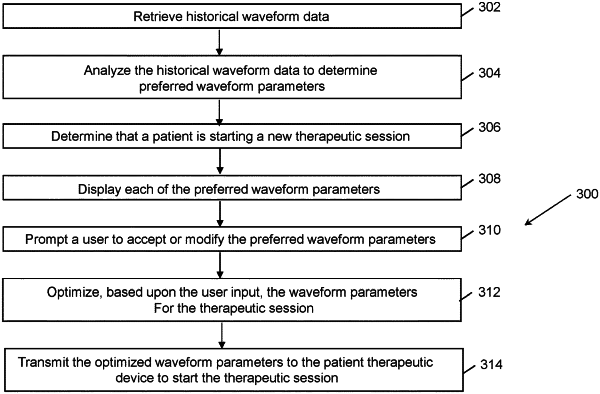| CPC A61N 1/36564 (2013.01) [A61B 5/0215 (2013.01)] | 18 Claims |

|
1. A computing system for optimizing a waveform, the computing system in communication with an implantable pulse generator, the computing system comprising:
a computing device including a memory device and a processor communicatively coupled to the memory device, the processor configured to:
retrieve, from the memory device, historical waveform data associated with a plurality of waveforms used in therapeutic sessions for a population of patients, the historical waveform data including a plurality of waveform parameters, the population of patients including a plurality of patients;
group each of the plurality of patients into an associated sub-set of a plurality of sub-sets of the population of patients, wherein each sub-set of the plurality of sub-sets groups patients based on at least one of age, height and weight, sex, disorder being treated, and beginning pain level;
analyze the historical waveform data to determine preferred waveform parameters;
determine that a patient is starting a new therapeutic session using a patient therapeutic device;
receive, from the patient therapeutic device, patient data associated with the patient;
compare the patient data with each of the plurality of sub-sets to determine a particular sub-set of the plurality of sub-sets that corresponds to the patient data;
determine, from the historical waveform data for the patients grouped in the determined particular sub-set, the preferred waveform parameters for the determined particular sub-set;
display, on a user interface, each of the preferred waveform parameters for the determined particular sub-set of the population of the patient;
prompt a user for user input associated with the preferred waveform parameters, the user input including accepting or modifying the preferred waveform parameters;
optimize, based upon the user input, waveform parameters for the new therapeutic session by analyzing, using at least one of machine learning and artificial intelligence, the historical waveform data for the patients grouped in the determined particular sub-set to determine patterns of the waveform parameters in the historical waveform data that led to desirable results for those patients; and
transmit the optimized waveform parameters to the patient therapeutic device to start the therapeutic session.
|